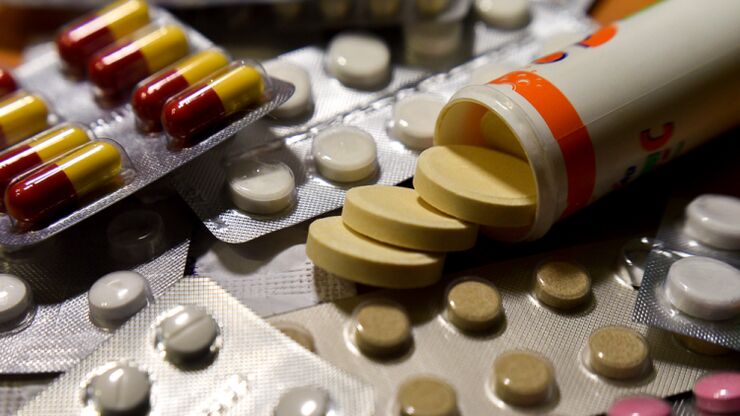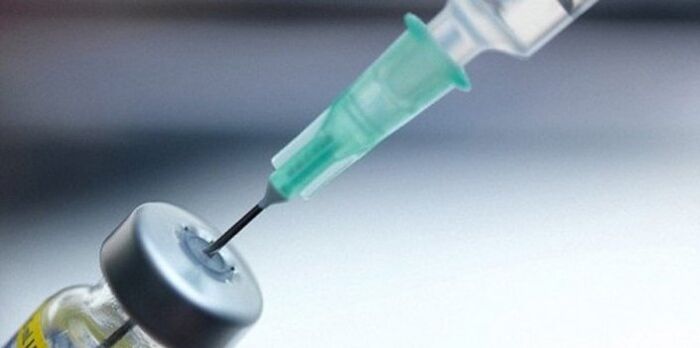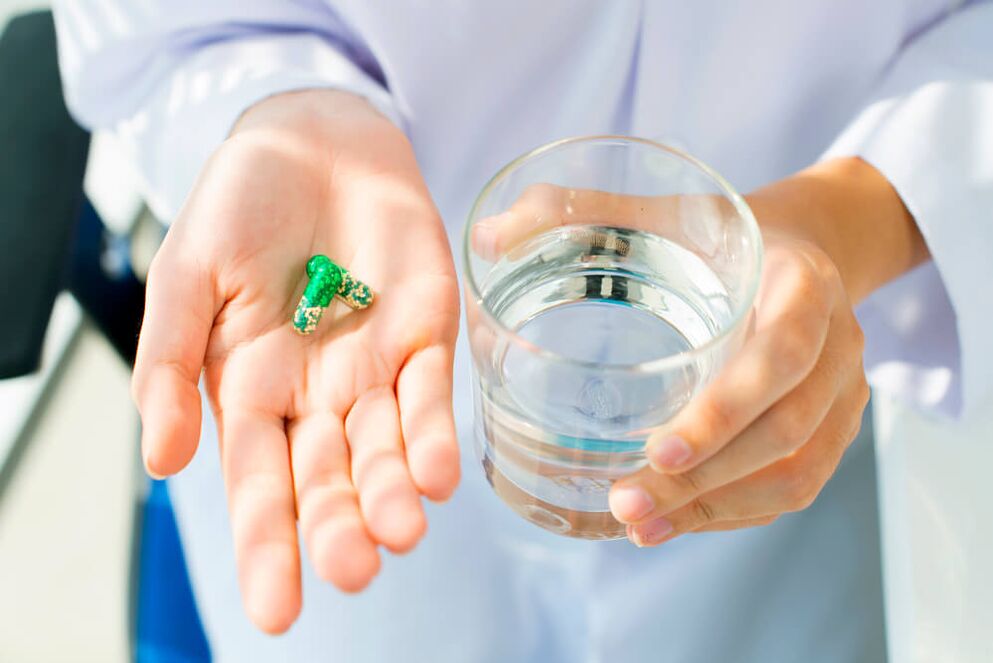Prostatitis is a fairly common male disease.
It can be infectious and non-infectious, with the first form being divided into bacterial and non-bacterial.
Treatment of prostatitis with antibiotics is carried out with an infectious bacterial lesion of the gland, even if the symptoms are not very pronounced.
Sometimes they are prescribed as a test therapy for non-bacterial forms.

Antimicrobial agents actively affect the pathogenic microflora, destroying pathogens of inflammation, and broad-spectrum antibiotics also become the prevention of complications that can affect the genitourinary system.
Classification of antibiotics for prostatitis
In acute or chronic inflammation, the doctor selects a drug from one or more groups of antibiotics to which microbes are sensitive. This is determined by the results of the analyzes.
All antibacterial agents can be divided into the following groups:
- penicillin;
- tetracycline;
- aminoglycoside;
- cefolosporin;
- fluoroquinolone;
- macrolide.

Penicillin group
Medicines in which the main substance is penicillin are antibacterial agents with a wide spectrum of action.
In this case, the substance can be of natural or synthetic origin. The advantage of this group of medicines is its affordable price and the ability to use tablets (or suspensions) at home.
Among the wide list of penicillin antibiotics, the most common is the penicillin of the same name, which is most often prescribed for chronic inflammation.
Group of tetracyclines
Tetracycline as an antibiotic for prostatitis can be prescribed for external use in the form of an ointment or in the form of tablets for oral administration.
The substance effectively kills streptococci, staphylococci, salmonella, chlamydia, shigella and a large group of other microbes, while being rapidly absorbed into the prostate tissue.
Recently, tetracycline drugs are used in urology less and less because of the large number of side effects (especially from the gastrointestinal tract).
Among the disadvantages of drugs, one can single out the formation of resistance of microorganisms to tetracycline drugs, as well as a number of side effects:
- intestinal colic;
- nausea;
- digestive disorders;
- anemia;
- eosinophilia;
- increased intracranial pressure;
- liver damage;
- allergy.
Aminoglycoside group
The drugs have long been used as antibiotics for prostatitis in men with a wide range of effects. However, these medicinal products are highly toxic.
The most common use of the drug, which is highly effective in the fight against gram-negative pathogens of bacterial inflammation, which include Pseudomonas, Proteus, Klebsiella, Salmonella, Enterobacteriaceae.
They are inexpensive and quickly absorbed into the bloodstream - the maximum plasma concentration is reached an hour after ingestion.
Cons of funds:
- Limited spectrum of action - it is used only as an additional agent to combat certain pathogenic microorganisms in the complex therapy of inflammation of the prostate gland.
- It can cause many side symptoms, including: headache, renal failure, vomiting, nausea, hearing loss, anemia, leukopenia, drowsiness, oliguria (a decrease in the amount of urine excreted compared to normal), and others.
- The drug is not sold in oral forms - it is injected bypassing the gastrointestinal tract through injection and injection.
Group of cephalosporins
These antibacterial agents are also not intended for oral administration, they are administered parenterally. They are often prescribed for inpatients.
The funds act on gram-positive pathogens, a small group of anaerobes and gram-negative bacteria.
Funds are often prescribed to combat complicated prostatitis, which is caused by E. coli, enterobacter, gonococcus, staphylococcus, Proteus, Klebsiella and other pathogens.
It is to these funds that doctors turn to if the infection could not be defeated with penicillins, tetracyclines and other antibiotics.
Among the additional advantages of drugs are an acceptable cost and a minimum of contraindications (the exception is hypersensitivity to this type of antibiotics).
Like all antibacterial agents, cephalosporins have side effects:
- headache;
- allergic skin rashes and local reactions at the injection site;
- intestinal and gastric disorders;
- colitis and others.
Fluoroquinol group
These medicines are used in the complex therapy of chronic inflammation of the prostate, since they quickly penetrate into the tissues of the gland and have a long-term effect.
It is advisable to drink them if the disease is caused by mycobacteria, gram-positive and gram-negative microorganisms, chlamydia or mycoplasma.
Among the side effects, in addition to the typical antibiotic vomiting, nausea and diarrhea, there is ICP, tachycardia, fatigue, leukopenia, anemia, and impaired renal function.
Important!Medicines cannot be combined with certain medications. For example, with adenosergic drugs, the combination with which dramatically lowers blood pressure. It is also not recommended to drink drugs together with non-steroidal anti-inflammatory drugs, since their combination increases the negative effect on the nervous system.
Macrolide group
They are sometimes used to treat prostatitis caused by chlamydia or mycoplasma. However, in relation to other potential pathogens, their effectiveness has not been confirmed.
Treatment regimen
What kind of antibacterial agents to take is decided by the doctor after conducting tests to determine the type of pathogen and its sensitivity to medications.
Antibiotics are only part of the treatment for acute and chronic infectious prostatitis, which includes a whole list of complementary drugs.
The standard therapy system includes:
- Antibacterial drugs - to destroy the source of inflammation.
- Stimulants of blood circulation - to exclude stagnation of blood in the small pelvis.
- Anti-inflammatory medicines - to relieve swelling and pain.
- Immunomodulators - to maintain and activate the body's defense system;
- Sedatives;
- Vitamins and microelements (zinc, magnesium, selenium, vitamins A, B, C, E);
- Herbal infusions and teas (elderberry, lingonberry, St. John's wort, comfrey);
- Exercise and prostate massage - to stimulate circulation and reduce congestion.

Acute inflammation
In acute form, both home therapy under the supervision of a doctor and inpatient treatment are possible.
In this case, drugs are prescribed that act comprehensively and widely: first they resort to powerful drugs from the list of cephalosporins, and with improvements they switch to fluoroquinols.
Sometimes it is advised to take two types of antibiotics at once for the fastest possible cure.
In acute inflammation, the reaction to medication manifests itself quickly enough - the symptoms go away within a few days.
But even with the relief of the condition, you cannot interrupt the course and change the dosage prescribed by the urologist. This can lead to the transition of the disease into a chronic form and the formation of bacterial resistance to drugs.
If everything is done correctly, prostatitis is 100% cured without complications.
Chronic process
Compared with the acute form, the treatment of sluggish inflammation with periodic exacerbations is more complex and prolonged. This is due to changes in the tissues of the prostate, which are less sensitive to and "keep" antibacterial drugs in their cells.
Nevertheless, for the chronic course, antibiotics of the following groups are most effective:
- cephalosporins;
- fluoroquinols;
- macrolides.
The duration of therapy is at least a month, but usually this is not enough, so the doctor prescribes several courses at once at equal intervals. It is important to follow these guidelines, even if it gets better: the feeling can be deceiving and will only make the problem worse.
Conclusion
When symptoms of prostatitis appear, do not waste time looking for a solution on forums and thematic sites. It is important to see a doctor before the disease becomes severe and complications begin with serious consequences for men's health.























